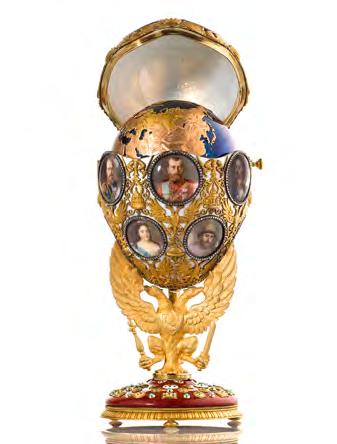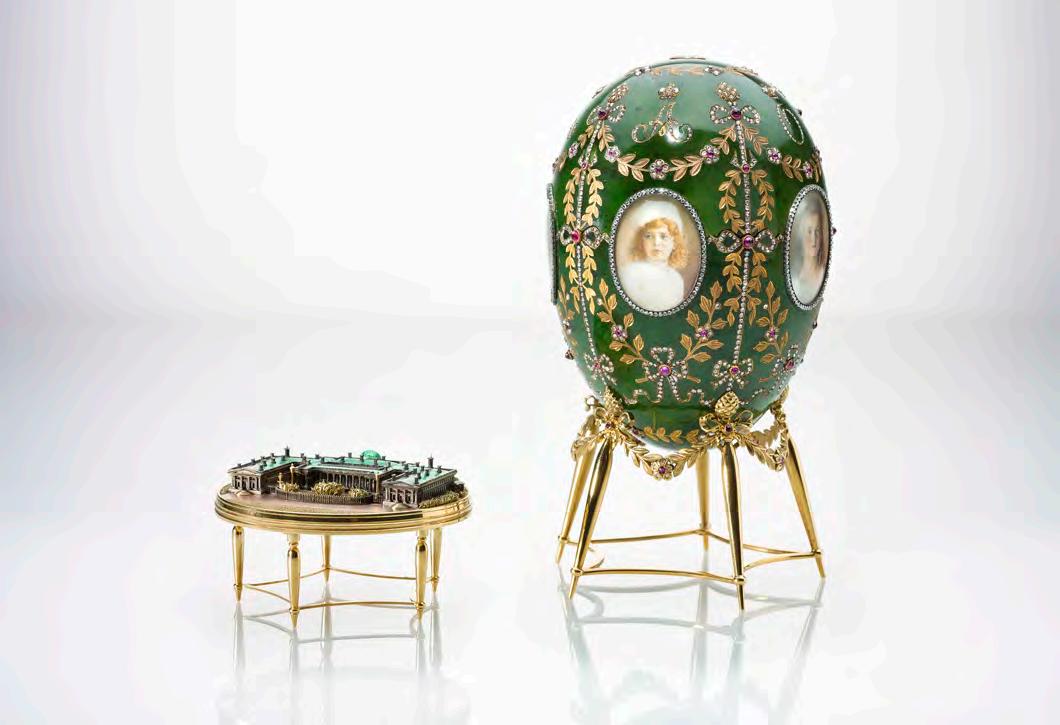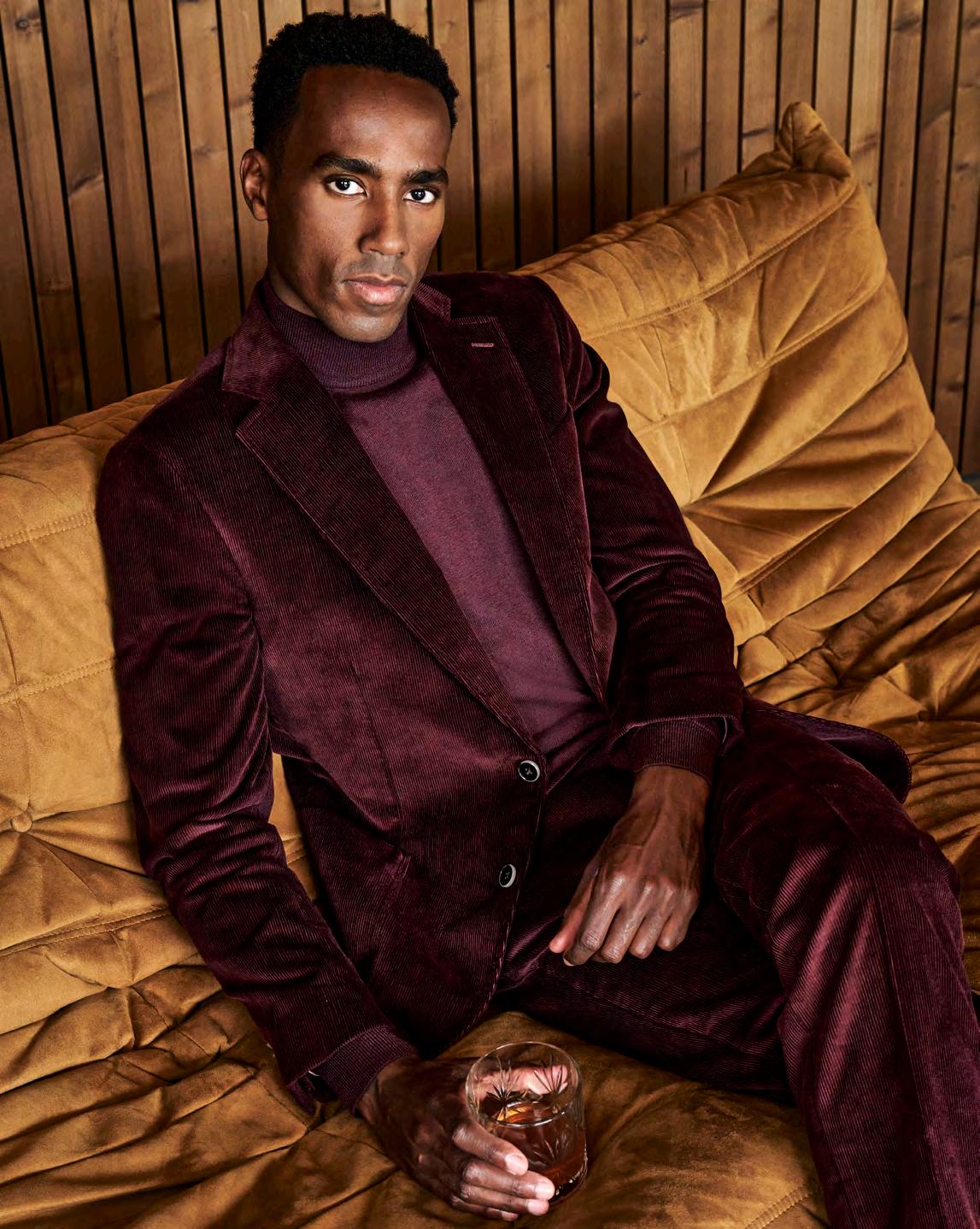
8 minute read
SHELL SHOCK
SHELL SH CK
Lenin, communism & the hunt for the Fabergé Eggs
Advertisement
THE SEARCH FOR THE MISSING FABERGÉ EGGS REMAINS THE LONGEST EASTER EGG HUNT IN HISTORY. TO COINCIDE WITH THE VICTORIA AND ALBERT MUSEUM’S NEW EXHIBITION, ‘FABERGÉ IN LONDON: ROMANCE TO REVOLUTION’, LUXURY LONDON LOOKS AT WHAT HAPPENED TO THE JEWELLERY FIRM AND ITS FOUNDING FAMILY FOLLOWING RUSSIA’S BLOODY 1917 OCTOBER REVOLUTION
Words: Rob Crossan
When the men finally came, armed and drunk on ideological fervour, Carl Fabergé knew better than to try and resist. “Give me 10 minutes to put on my hat and coat,” he said.
These are the words, according to sources from the time, that the founder of arguably the world’s greatest jewellery firm uttered before his empire was lost to communism.
Kitsch, extravagant and with its origins in organised religion, it would be hard to think of a single artefact that better symbolised everything the Bolsheviks wanted to destroy than the Fabergé egg.
Every Easter from 1885 until 1917, when the Russian Revolution began, the eponymous St. Petersburg-based jewellery company was commissioned by the ruling Tsar to create Easter eggs for his beloved Tsarina.
When Nicholas II, who would be Russia’s last Tsar, came to the throne, he continued the tradition, asking Carl Fabergé to make eggs for the new Tsarina Alexandra, as well as his mother.
These bejewelled creations – 69 are thought to have been produced by the end of the Nicholas II’s reign – were highly symbolic of the rarefied world in which the ruling family existed. While millions of Russians went hungry or were being killed during the seemingly interminable Great War with Germany, the Romanovs had a royal yacht with an on-board cow, so that the family could enjoy fresh milk each morning.
The Fabergé firm, founded by Carl’s father in 1842, had developed a global reputation for creating cigarette cases, vases, picture frames, clocks and crucifixes. Using gems, glass, wood and precious metals, the flamboyant and occasionally outright garish Fabergé style reached its zenith with the Easter eggs.
Ingenious in design, the eggs were the fullest manifestation of Carl and his team’s devotion to ingenuity and quality; perhaps reaching its highest point in the form of the infamous 1897 egg given to Tsarina Alexandra. In translucent lime green enamel, trellised in gold, and crowned and studded with diamonds, the five-inch-high egg opens to reveal a working model of the Coronation coach in yellow gold and rose diamonds.
The story of how the Revolution destroyed Fabergé and scattered his bejewelled eggs across the world for nigh on a century can be encapsulated in one phrase: “Everything seems sad”.
This is what Carl Fabergé wrote in a letter that was intercepted by state
authorities shortly after the first of 1917’s two revolutions; the initial revolt resulting in the appointment of a provisional government known as the ‘Duma’, which planned for democratic elections.
The weakness of the Tsar’s leadership, the bloodshed on the battlefields, and his reluctance to make any liberal concessions meant that a military coup d’état or a people’s revolution of some description was all but inevitable.
But even before the revolutions that would create the iron grip of Stalinism, the early Bolsheviks put Carl Fabergé under surveillance. His coterie of foreign friends and buyers of his creations made him an instantly untrustworthy individual in the eyes of the revolutionaries.
The previous year, Carl had turned his firm into a joint stock partnership, a paper-thin attempt to assert a more democratic demeanour for his company in the hope of preventing it being torn apart by what he knew would be a seismic and imminent political upheaval.
It was in Fabergé’s home city, now called Petrograd, rather than St Petersburg, that the first revolution began in February 1917. Every military regiment in the city mutinied, policemen were shot and prisons were ‘liberated’ as mob rule took hold.
But the provisional government that emerged could do nothing without the support of the Petrograd Workers’ Committee, or ‘Soviet’ as it was also known.
Not capable of winning more than a few seats on its own in a democratic election, the Soviet nonetheless had support among the lower ranks of the army and the proletariat.
For Fabergé, there was a sense that he could at least do business with the provisional government. His factories were now contributing to the war effort to make munitions rather than cigarette cases and business was good with many wealthy Russians keen to exchange their cash hoards for objects of desire that could be more easily concealed and smuggled out of the country.
Perhaps, despite the surveillance being put upon Carl and his family, all was not
lost? Alas, the interim government proved to be no match for the return of a certain Vladimir Ilyich Ulyanov, better known by his alias Lenin, who’d been living in Paris, London and modern-day Poland since he was charged with sedition and exiled to Siberia for three years in 1897.
Lenin then went to Western Europe before returning to Russia in a sealed train. He called for an immediate end to the grinding war with Germany and slowly but inexorably gained support among Russia’s urban poor. Unrest and riots followerd, leading to Lenin exiting briefly to Finland. By autumn, the conditions were right for the Bolsheviks to wrest control away from the provisional government and alter existing plans which would have seen the Tsar and his family permanently exiled to Siberia.
Despite being worth around £4 million in today’s money, the Romanovs didn’t take their Fabergé eggs with them when they were kicked out of the palace. Orders stated that they were to take only essential belongings, so, for reasons of space and economy, the eggs were left in Petrograd.
As the entire provisional government was arrested, the civil service dismantled, the White Palace stormed and the Romanovs put on soldiers’ rations, the doomed former ruling family spent Easter 1918 making its own decorative Easter eggs in a melancholy homage to the joys of previous years.
That summer, the family was told to travel from its exiled base in Siberia to Moscow, where it was to be put on a grand show trial. The Tsar, his wife and children were taken only as far as the Ural city of Ekaterinburg. It was here, in the basement of a building named by the Soviets as the ‘House of Special Purpose’, that in the early morning of 17 July the entire family was shot dead.
Carl Fabergé, miraculously, avoided a similar fate. Identified by Lenin’s righthand man, Leon Trotsky, as being a target for having profited from the war, Carl’s two sons had already been arrested. It was clearly obvious that the leading Bolsheviks (now renamed the Russian Communist Party) viewed the Fabergé family, and their jewellery firm, as representing a parasitic anachronism of the old days.


THIS PAGE THE ALEXANDER PALACE EGG, 1908 OPPOSITE PAGE, FROM TOP THE MOSCOW KREMLIN EGG, 1906; THE ROMANOV TERCENTENARY EGG, 1913; THIRD IMPERIAL EGG, 1886–7. THE EGG WAS PURCHASED BY AN OBLIVIOUS AMERICAN IN 2015 WHO PLANNED TO MELT IT DOWN FOR GOLD. ALL IMAGES © THE MOSCOW KREMLIN MUSEUMS
With their company nationalised almost overnight, it became all but worthless as inflation spiralled out of control in the new communistrun nation. Just a few months after the new ‘Committee of the Employees of the Carl Fabergé Company’ was formed, in November 1918 the entire firm was closed down.
“There we stood,” recalled one engraver, Jalmari Haikonen, “silent, with aching hearts, looking at the workshop around us.”
Carl himself had fled the city alone two months earlier. Like many wealthy Russians, he was fully expecting the Tsar to be overthrown but had no idea as to the scale and bloodlust of the revolution that would follow.
Managing to take a small amount of money with him, Carl’s first refuge was Latvia until, in 1919, it was attacked by the Red Army. Fleeing to Berlin, which was in the midst of a civil war, he eventually found relative sanctuary in the Rhine spa town of Rhisbaden, and finally Lausanne, Switzerland.
Joined by his wife, Augusta, Fabergé was weak, fatigued and was said to have frequently muttered, “this is life no more,” in his final days.
Carl Fabergé died on the 24 September 1920 aged 74. His jewellery firm was non-existent, the whereabouts of the eggs were mostly unknown and the Russia he knew had vanished, replaced by one of the most terrifying authoritarian regimes of the 20th century. Later, under Stalin’s rule, the eggs which had been confiscated and taken to the Kremlin were sold to overseas buyers.
Of the 69 eggs that Fabergé created, 57 are known to have survived. In a contemporary Russia where the extravagance of modern-day oligarchs bears similarity to the decadence of the

Carl Fabergé died in 1920, his jewellery firm non-existent, the whereabouts of Romanovs, it is perhaps apt that in 2004 the potentate businessman the eggs mostly unknown Viktor Vekselberg bought nine Fabergé eggs at a Sotheby’s auction for a figure rumoured to be around £75 million. They are now displayed at his own museum in St. Petersburg. The search for the missing eggs remains the longest Easter egg hunt in history. In 2015, a man from the American Midwest (who chose to stay anonymous) bought a gold ornament at auction. Given the soaring price of gold, he planned to melt down the egg and sell the precious metal for $500. Frustrated by the low prices he was being offered, the man did a quick Google search to discover that what he’d actually bought was the Third Imperial Easter Egg. Today, the egg is worth approximately £20 million. ‘Fabergé in London: Romance to Revolution’ opens at the Victoria and Albert Museum on 20 November, £18 for adults, vam.ac.uk

WWW.LAURENROSSDESIGN.COM

Scabal is the fabric specialist that supplied the velvet for Daniel Craig’s pink jacket, but its Hollywood clientele doesn’t stop there (p.102)
Couture

CUT FROM A DIFFERENT CLOTH










